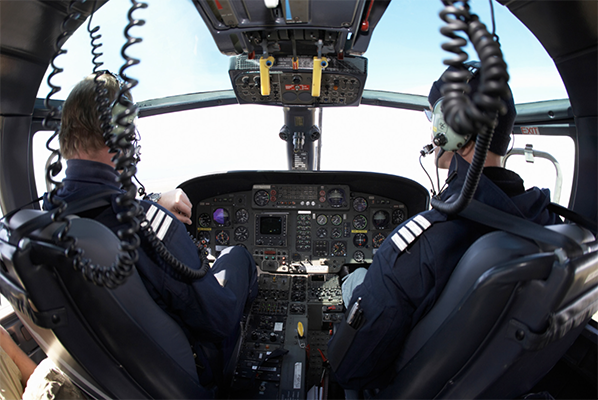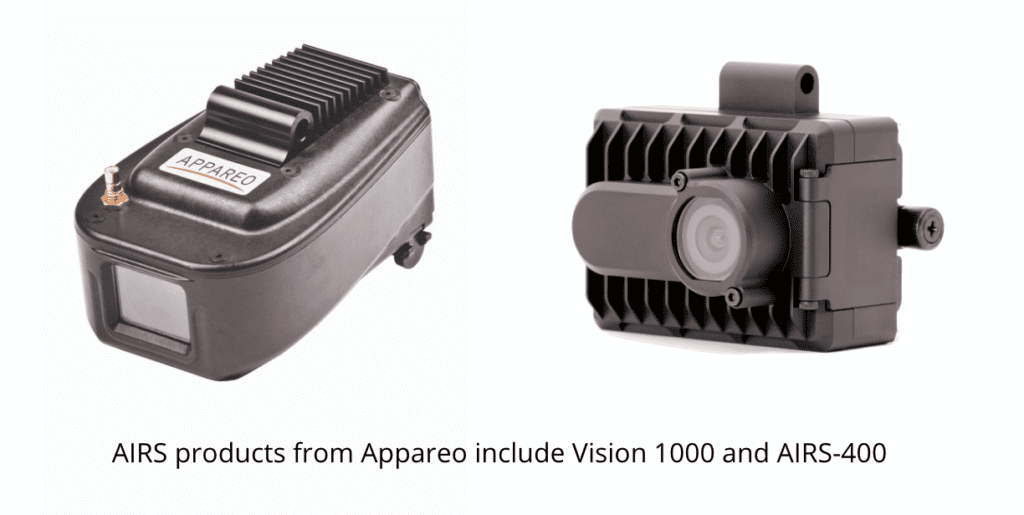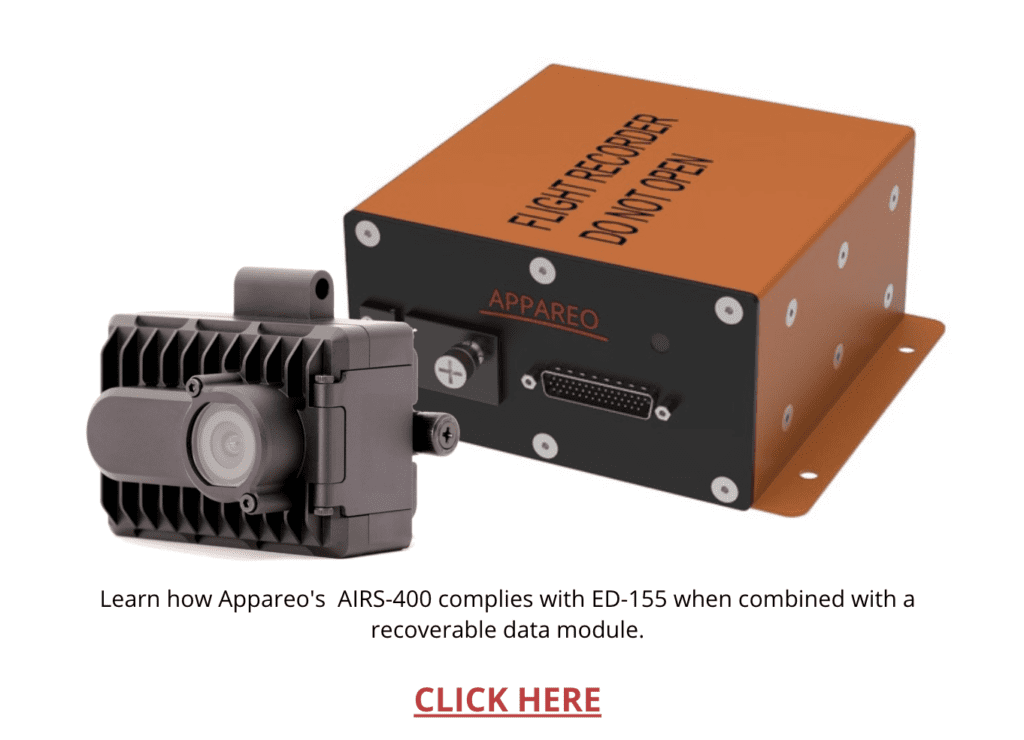At Appareo we get a lot of questions about ED-155. These questions are sometimes in reference to our recoverable data modules and other times in reference to our airborne image recording systems.
ED-155 is the minimum operational performance specification for a lightweight flight data recording system. The specification was created in response to industry pressure to provide lighter flight recorders as smaller aircraft were increasingly receiving pressure to carry flight recorders. ED-155 was also created to encourage modernization of flight data recording technologies, moving away from standards that support old recording media like magnetic tape.
In this article we will talk about:
- General standards
- Standards for Deployable Recorders; and
- Requirements that cater to different kinds of recording systems, including:
-
- Cockpit Audio Recording Systems (CARS) – a cockpit voice recorder, with ambient audio data acquisition
- Aircraft Data Recording Systems (ADRS) – a flight data recorder
- Airborne Image Recording Systems (AIRS) – a cockpit camera
- Data-Link Recording Systems (DLRS) – a cockpit voice recorder but for digital data rather than cockpit voice
General Standards
The general standards that address all recorder types include requirements for basic operation, safety, retention of recorded information, and survivability. The survivability standard covers requirements for impact/shock, crush, and flame survivability that are in excess of tests encountered in standards like RTCA DO-160. There is also a requirement that the survivable memory component of the flight recorder be bright orange and labeled with the words “FLIGHT RECORDER” in black letters.
Standards for Deployable Recorders
A deployable recorder is a recorder that is designed to come free from an aircraft in an accident sequence. In general, the objective of these recorders is often to pair them with a locating beacon and a means of flotation to allow the recorder to float and be recovered independent of the wreckage for incidents that occur over deep water. These recorders are typically mounted on the exterior of the aircraft. In Appareo’s experience, the smaller nature of the aircraft that are often under consideration for ED-155 recorders has made it unusual for us to encounter interest in deployable recorders of this size. Regardless, the standard provides for additional environmental and survivability testing criteria for ED-155 compliant recorders designed with this feature in mind.
Four System Categories
ED-155 specification provides a very comprehensive set of requirements that address almost any conceivable type of recording system. This may be confusing because there are no specific international mandates that decompose the five different categories of ED-155 and call on a specific subset of requirements to be compliant with a standard. Rather, the standard provides guidelines for a variety of different systems.
1. Cockpit Audio Recording Systems (CARS)
CARS is a system that records both ambient area audio data (i.e. the noise inside the cockpit) as well as the pilot audio channel(s). The ambient area audio data allows accident investigators to listen to particulars of an incident, which can sometimes provide insights regarding aircraft mechanical failures (e.g. forensic analysis of turbine engine noise). The recording of pilot communications provides insights into pilot decision-making, communication between pilots, and interactions with air traffic control. In some recorder systems, the pilot audio channels and the cockpit area microphone data can be delivered by different system components.

The specification declares the performance and recording requirements (e.g. total recording capacity, recording delay tolerances, etc) for both the ambient and pilot sources, while adding requirements or provisions for other capabilities (e.g. requiring a build erase function to be present). The standard also provides for the test requirements and procedures necessary to demonstrate a CARS’ performance against the standard’s requirements.
2. Aircraft Data Recording System (ADRS)
ADRS is a system that records digital flight data in an uncompressed format. The ED-155 standard allows for a variety of aircraft data sources, which is an effort to accommodate the wide variety of aircraft on which such recorders were intended to be installed. For example, acquiring flight data on helicopters that are not equipped with digital data buses as a portion of the avionic equipage may not be impractical – as a result the standard allows for sensors interior to the ADRS to record such data (e.g. pitch/roll data from an IMU, GPS data, etc). Alternatively, a smaller aircraft used for business transport purposes may provide practical access to a digital data bus (e.g. ARINC 429) and the standard provides performance requirements for recording from such sources.
Much like the CARS, the ADRS specification declares performance and recording requirements for the ADRS while also specifying which parameters must be recorded, and at what frequency, for a unit to qualify as an ADRS.
3. Aircraft Image Recording System (AIRS)
AIRS equipment is deployed for the intent of capturing image data regarding aircraft operation, which is typically then synchronized in time with the recording of other recorder types. For example, synchronizing AIRS with a CARS will provide a synchronized playback of image and audio data from a flight. Likewise, synchronizing AIRS and ADRS can provide data to create synchronized cockpit video with flight animations.

AIRS systems are separated into six different classes. The classes are described by alpha characters (A through F) and are organized as following:
Class A provides a general image of the cockpit including instruments and a view of external environment (through the glareshield).
Class B provides a recording of the data-link message display.
Class C provides for a means of recording flight data where it is not possible or prohibitively expensive to otherwise do so.
Class D provides a means for capturing heads up displays.
Class E provides a means of capturing other camera images present to pilots (e.g. as a means of capturing cargo or cabin views presented to pilots).
Class F provides means for capturing an external view of the aircraft.
The standard provides guidance for operational considerations, like what portions of the cockpit to capture in the image frame and provisions for data security/privacy (e.g. preventing AIRS data from being easily played back by non-investigative personnel, as well as performance requirements in the areas of recording capacity, recording delay, and image compression.
4. Data Link Recording Systems (DLRS)
Often when people refer to flight data recorders the physical interface between the flight data recorder and the aircraft is often done through ARINC 717. The objective of a DLRS is to record the messages passing to and from the aircraft via digital means, which is typically accomplished using a standard avionic digital interface like ARINC 429. In this manner, the DLRS is attempting to acquire information like data exchanged through CPDLC, digital ATIS, NOTAM delivery, etc.
If you’re still trying to understand ED-155, your requirements, and how to show compliance, please contact Appareo at [email protected].
To learn how Appareo’s AIRS-400 can comply with ED-155, click here.
 David Batcheller
David Batcheller
President & CBO


